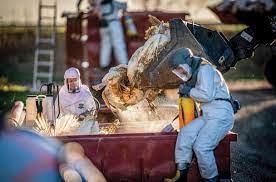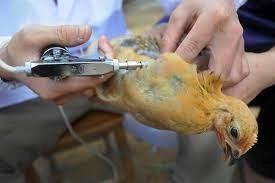The traditional approach to stamping-out Highly Pathogenic Avian Influenza that occurs as sporadic outbreaks is outmoded. This is evidenced by the current H5N1 panornitic involving North America, Europe, Eurasia and parts of Africa.

Vaccination is under evaluation as a component of integrated control programs including biosecurity and flock depletion. It is evident that once a flock is infected, removal and disposal is justified based on the need to prevent multiplication and dissemination of virus. If, however, populations and especially those in areas with a high concentration of poultry are immunized, the rate of spread may well be diminished, reducing the financial impact of infection.
Vaccines are used for many catastrophic diseases of livestock in combination with judicious depletion. Fear of losing potential exports as a result of application of vaccine that implies an endemic status has limited the use of vaccines. Oil emulsion products homologous with the hemagglutin of the infected virus have been moderately successful in suppressing strains of Avian Influenza in Mexico, China, Italy and other nations. China has achieved success with H7 Avian Influenza vaccine specifically to prevent H7N9 infection of consumers of chicken purchased at wet markets.
 Advances in vaccine technology offer the prospect of more effective immunization. Boehringer Ingelheim has developed Volvac® B.E.S.T a bacculovirus vectored Newcastle disease and H5N1 avian influenza product now deployed in Mexico and Egypt against H5N1. Ceva has developed an RNA vaccine that is undergoing tests in domestic waterfowl in France under the control of the Agency for Food, Environmental and Occupational Health and Safety.
Advances in vaccine technology offer the prospect of more effective immunization. Boehringer Ingelheim has developed Volvac® B.E.S.T a bacculovirus vectored Newcastle disease and H5N1 avian influenza product now deployed in Mexico and Egypt against H5N1. Ceva has developed an RNA vaccine that is undergoing tests in domestic waterfowl in France under the control of the Agency for Food, Environmental and Occupational Health and Safety.
If importing nations recognize the World Organization of Animal Health principle of regionalization, embargoes following outbreaks of Avian Influenza can be confined to specific regions. The fact that Avian Influenza is now a panornitic and is spread by migratory waterfowl implies seasonal endemnicity with recurring outbreaks over extensive areas. This situation now demands extremely expensive control campaigns with the inevitability of reintroduction on a seasonal basis.
|
With the evolution of HPAI as a panornitic new control modalities are required especially in areas with a high density of poultry. An effective vaccine should be regarded as a component of an integrated system to suppress outbreaks of HPAI. Eradication, even on a national basis, appears unlikely for extended periods. Epidemiologic resources including genome sequencing, development of a new range of vaccines with recognition that HPAI is an international problem, should lead to new approaches based on prevention. It is self-evident that programs should take into account that migratory waterfowl and other birds disseminate Avian Influenza viruses over extensive distances and shed virus over a relatively long duration. The need for multi-billion dollar eradication campaigns conducted at more frequent intervals will justify flexibility in approaching a disease that has both impact on livestock and zoonotic potential.
|

|

|